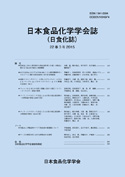29 巻, 2 号
選択された号の論文の8件中1~8を表示しています
- |<
- <
- 1
- >
- >|
論文
-
2022 年 29 巻 2 号 p. 61-68
発行日: 2022/08/30
公開日: 2022/08/30
PDF形式でダウンロード (1570K) -
2022 年 29 巻 2 号 p. 69-76
発行日: 2022/08/30
公開日: 2022/08/30
PDF形式でダウンロード (1054K) -
2022 年 29 巻 2 号 p. 77-84
発行日: 2022/08/30
公開日: 2022/08/30
PDF形式でダウンロード (1079K) -
2022 年 29 巻 2 号 p. 85-90
発行日: 2022/08/30
公開日: 2022/08/30
PDF形式でダウンロード (859K) -
2022 年 29 巻 2 号 p. 91-103
発行日: 2022/08/30
公開日: 2022/08/30
PDF形式でダウンロード (2012K) -
2022 年 29 巻 2 号 p. 104-113
発行日: 2022/08/30
公開日: 2022/08/30
PDF形式でダウンロード (982K)
ノート
-
2022 年 29 巻 2 号 p. 114-123
発行日: 2022/08/30
公開日: 2022/08/30
PDF形式でダウンロード (850K) -
2022 年 29 巻 2 号 p. 124-133
発行日: 2022/08/30
公開日: 2022/08/30
PDF形式でダウンロード (2867K)
- |<
- <
- 1
- >
- >|
